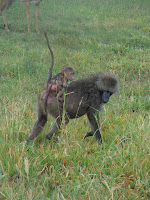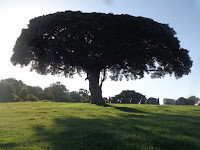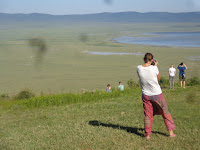I know, I know, there was a noticeable lack of animals in my safari post. Forgive the buildup, but I was saving the best for last. Finally, here are the fruits of my Cyber-shot's labor. Seriously, these were all taken with a point-and-shoot; no extra telephoto lens required. I have accompanied the dik-dik pics and other animal photos with some life lessons learned while watching creatures great and small.
It's important to build a community when you live in the wild (and when you live in the 'burbs, I suppose). Contrary to its possibly promiscuous name, the aforementioned dik-dik is one of the few monogamous antelope species, breeding with a single partner at a time (top left). Lovebirds literally got their names because they mate for life (top right). But what if you can't find your soulmate? It's okay to settle for a mutually beneficial relationship. For example, you might know that thousands of termites live together in those huge mud mounds, but did you know that mongoose frequently move in to the dens, sharing space with the insects (bottom)? Not a bad model for gentrification.



If you can't stand out due to your appearance, you can find your niche in other ways. Giraffes have distinctive dots, but they also distinguish themselves with their diet; the treetops are a smorgasbord open only to them. Most animals cluster in the lush interior of Ngorongoro Crater, so there's plenty of dining space on the exterior hillsides, which is convenient for the giraffes since the crater walls are too steep for them to climb down (top left). Elephants, on the other hand, feast on a buffet of bushes on the ground (top right). You might think the hornbill's curved beak is a culinary tool, but actually, the blood vessel-filled schnoz helps them regulate their temperature, as grass-insulated nests do for the golden weaver (bottom).
Depending on the time of year, food and water can be scarce in the grasslands, so sometimes you gotta go where the goods are. Herds of animals can be found descending on a single puddle of refreshment (top left). Some species' entire lives are built around moving to find sustenance and shelter, such as the Great Migration of wildebeest (top right). Marabou stork migrate even further distances each day, and each night, they rest together in flocks for protection (bottom left). Flamingos at Lake Natron don't have to worry about predators or competition because they are one of the few animals who can tolerate the mildly toxic alkaline water (bottom right).
There's safety in numbers, but there's no rule that those numbers all have to be from the same species. Animals seem to be doing better than humans when it comes to sharing. Giraffes and elephants were able to belly up to the same water bar (top). Impalas seemed able to get along with just about everybody, from baboons (middle left) to warthogs (middle right). Hartebeest and Thompson's gazelles (not to be confused with the larger Grant's gazelles) always seemed to be hanging out together (bottom left). Birds of not the same feather can flock together, too, as shown by a kori bustard and ostrich (bottom right).
Most of the animals don't seem to have any antipathy toward the humans that invade their turf (top left). They pretty much go about their business, ignoring the people peeping at them, even when taking a bath (top right) or drying out after a bath (middle). The buffalo who grazed outside my tent for hours one night certainly seemed oblivious to how badly I needed to go to the bathroom. In general, animals just don't sweat the small stuff. They say cats don't like water, but we saw a cheetah that didn't mind the drizzling rain (bottom left) or our intrusion into its hunt (bottom right).
But obviously, life in the wild ain't a piece of cake. Every day, it's kill or be killed or maybe even both. We saw a leopard, like the cheetah, who was searching for a meal; in fact, it might have just found one because we thought we saw some fresh blood on its muzzle (top left). Some hyenas definitely made a score, although it probably was stolen after something else's dirty work (top right). A caracal stalked, caught, and consumed a mouse right in front of our eyes (bottom left). We didn't see this jackal snag his lunch, but we caught him in the act of enjoying his prize (bottom right).
It's important to build a community when you live in the wild (and when you live in the 'burbs, I suppose). Contrary to its possibly promiscuous name, the aforementioned dik-dik is one of the few monogamous antelope species, breeding with a single partner at a time (top left). Lovebirds literally got their names because they mate for life (top right). But what if you can't find your soulmate? It's okay to settle for a mutually beneficial relationship. For example, you might know that thousands of termites live together in those huge mud mounds, but did you know that mongoose frequently move in to the dens, sharing space with the insects (bottom)? Not a bad model for gentrification.



But even when you find your match, you still gots to do you. Like the human sphere, the animal world is awash in individual patterns and unusual colors. Zebras' stripes are as unique as snowflakes (top left). Giraffes' patches can be classified as geometric or flowery, but they are all different (top right). Topi aren't covered with stripes or spots, but they have characteristic dark-purple patches on their thighs (middle left). As with many species, the male version of the flat-headed rock agama is more showy -- and nicknamed Spider-man for good reason, I'd say (middle right). But don't be misled: You might think only manly grey crowned cranes have striking plumage, but the feathered halos are also a feminine trait (bottom).
Depending on the time of year, food and water can be scarce in the grasslands, so sometimes you gotta go where the goods are. Herds of animals can be found descending on a single puddle of refreshment (top left). Some species' entire lives are built around moving to find sustenance and shelter, such as the Great Migration of wildebeest (top right). Marabou stork migrate even further distances each day, and each night, they rest together in flocks for protection (bottom left). Flamingos at Lake Natron don't have to worry about predators or competition because they are one of the few animals who can tolerate the mildly toxic alkaline water (bottom right).
There's safety in numbers, but there's no rule that those numbers all have to be from the same species. Animals seem to be doing better than humans when it comes to sharing. Giraffes and elephants were able to belly up to the same water bar (top). Impalas seemed able to get along with just about everybody, from baboons (middle left) to warthogs (middle right). Hartebeest and Thompson's gazelles (not to be confused with the larger Grant's gazelles) always seemed to be hanging out together (bottom left). Birds of not the same feather can flock together, too, as shown by a kori bustard and ostrich (bottom right).
But obviously, life in the wild ain't a piece of cake. Every day, it's kill or be killed or maybe even both. We saw a leopard, like the cheetah, who was searching for a meal; in fact, it might have just found one because we thought we saw some fresh blood on its muzzle (top left). Some hyenas definitely made a score, although it probably was stolen after something else's dirty work (top right). A caracal stalked, caught, and consumed a mouse right in front of our eyes (bottom left). We didn't see this jackal snag his lunch, but we caught him in the act of enjoying his prize (bottom right).
It's possible the jackal, like the hyena, was eating someone else's leftovers. Later that same day, we saw how animals respect the chain of command when it comes to food. Apparently, the previous day, a couple of lions killed an antelope. They didn't eat it all in one sitting, so the next morning, the lion got first dibs on breakfast (top). After his respite, the lioness took a crack at the carcass (bottom left). Then when they slinked away for a sunbath, a pack of jackals descended on the remains (bottom right).
For some, watching this might turn their stomachs, but for me, it just seemed like a natural process -- you know, the circle of life (c'mon, you knew a Lion King reference was coming). First, there's procreation. It's a jungle out there even in the animal dating world. For many species, like hippos, competition for a mate is constant, even while just cooling off in the river (top left). Then the copulation is mostly just functional; a pair of lions went through the motions for literally less than two minutes before they settled in for a post-coital nap (top right). When the babies come along, the parents support their offspring (middle left) until they can stand on their own (middle right). And eventually, all earthly beings succumb to death and decomposition, leaving only their bones behind, such as this elephant jaw (bottom).











































































